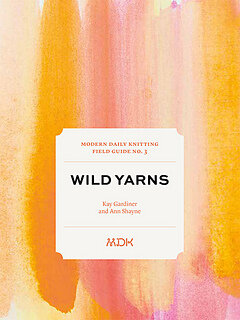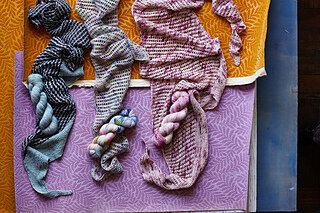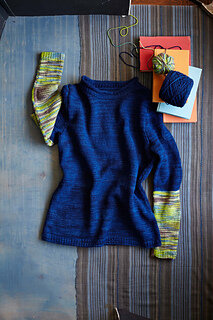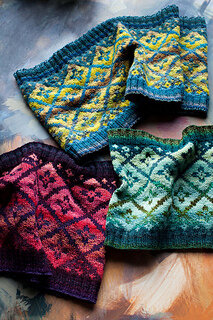MDK Field Guides No. 3: Wild Yarns




MDK Field Guides No. 3: Wild Yarns
The team at MDK say:
Hand-dyed, multicolor yarns are so easy to love.
Who among us—even the most diehard gray tweed advocate—has not fallen for these one-of-a-kind, special skeins? Like wayward puppies, they have a habit of following us home from fiber festivals and local yarn stores.
Apart from their beauty, we love the story of these yarns, the idea that they were made by hand, in a pot in the dyer’s kitchen or garage. The ultimate limited edition.
But what to make with them? Why are we reluctant to knit with the most beautiful yarns we can find? It may be because sometimes it’s hard to imagine what will come of a wild, hand-dyed yarn.
Maybe you’ve had this experience: A beautiful swan in the skein knits up into a duckling that only a mother could love, with ungainly blotches of color or wacky zigzags in all the wrong places. It doesn’t have to be this way.
The solution is to work with the inherent nature of these yarns. Embrace randomness! Leave room for surprise amid the order of a pattern. When we allow these exquisite yarns to behave as they please, the results are delightful—as the three patterns included in this Field Guide so perfectly demonstrate.
Dianna Walla, Kirsten Kapur and Sue McCain.
There's a bit of a back story to the name of these guides...
The two American women, Kay Gardiner and Ann Shayne, who produce these guides run a company now known as Modern Daily Knitting, but up until a month ago the company was called Mason-Dixon Knitting. Ann and Kay were originally pen pals living in Nashville and New York respectively. They chose the name, it seems, to reflect that fact that one lived in the south and the other in the north of the USA.
I confess when I first ordered these guides in June 2020, just after they had changed the company name, I didn't realise the significance of the original name. But comments I saw online made me do a bit of homework. From Wikipedia I discovered that:
The Mason–Dixon line is a demarcation line between four U.S. states, forming part of the borders of Pennsylvania, Maryland, Delaware, and West Virginia (part of Virginia until 1863). It was surveyed between 1763 and 1767 by Charles Mason and Jeremiah Dixon in the resolution of a border dispute involving Maryland, Pennsylvania, and Delaware in Colonial America. It later became informally known as the border between the free (Northern) states and the slave (Southern) states. The Virginia portion was the northern border of the Confederacy. It came into use during the debate around the Missouri Compromise of 1820, when the boundary between slave and free states was an issue. It is still used today in the figurative sense of a line that separates the North and South politically and socially.
Having read this, I can understand the impetus for change and appreciate their choosing to act on it. My stock, however, was printed before the change took place and still carries the old company name. I have added this explanation to the website so that customers are aware of the situation.
